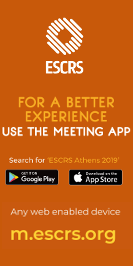Posters
(results will display both Free Papers & Poster)
Refractive error regression in myopic eye after infectious keratitis
Poster Details
First Author: L.Muceniece LATVIA
Co Author(s): A. Zemitis G. Laganovska
Abstract Details
Purpose:
To report an unexpected positive refractive outcome for myopic patient after infectious keratitis. Contact lens wear is the main predisposing factor for infectious keratitis. Corneal scaring, reduced corneal transparency and irregular astigmatism are main causes of poor visual outcome.
Setting:
Ophthalmology Department, Pauls Stradinš Clinical University Hospital, Latvia;
Riga Stradiņš University
Methods:
A 44-year-old caucasian male came in department with severe pain, tearing and reduced vision in the right eye for 2 days. Patient used prescribed -6,0 diopters monthly disposable contact lenses in both eyes. First slit-lamp examination revealed 2,57x1,49mm large epithelial defect. OCT-A confirmed only epithelial defect, 554μm corneal infiltrate and corneal endothelium swelling. Corneal thickness variated from 874μm to 943μm. Patient was treated with hourly doses of 0,5%Levofloxacin eye drops, 1 time per day 0,1%Dexamethasone and 0,2%Chloramphenicol ointment. Treatment was hold for 14 days. Anterior segment changes were monitored with OCT-A, fluorescein staining and anterior segment photography.
Results:
Endothelial swelling disappeared after 3 days. Fluorescein staining was not noticeable after 4 weeks. Eight weeks after infection patient noticed better uncorrected visual acuity in the right eye compared to the left eye. OCT-A reveal central hyper-reflective area thru all cornea. Keratometry readings for right eye K1:37,21Dx200 K2:41,06Dx1160. Twelve weeks after keratitis episode keratometry readings changed to K1:38,97Dx260 K2:41,41Dx1160. Subjective refraction of right eye showed visus 0,5 -0,5/-1,0 x 200=0,8. As well autorefractometer data showed -2,5/ +0,75 x 1010. At this moment patient is using soft contact lens in the left eye and no refractive correction for the right eye.
Conclusions:
Following the scaring after corneal ulcers, patients usually suffer from severe visual problems. Specific corneal ulcer placement and it’s scaring can reduce refractive error.
Financial Disclosure:
None



